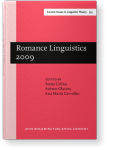Word-minimality and sound change in Hispano-Romance
This paper proposes that word minimality, correlated with a bimoraic foot, provides a unitary account of three separate historical developments in the Hispano-Romance languages, to date considered unrelated: the preservation of a word-final nasal, the change /ee/ > /ej/, and yod augmentation in four present 1st person verb forms: soy, doy, voy and estoy. It is suggested that two otherwise regular sound changes, -m deletion and identical vowel simplification (/ee/ >/e/), failed to occur in a small number of lexical items in order to avoid their impeding reduction to a subminimal size, and that yod accretion in the Old Spanish monosyllabic forms do, so, vo, and estó was also driven by compliance with a minimal word requirement. In support of this analysis is the empirical evidence from the historical evolution of Hispano-Romance, which points to a weight-sensitive metrical system in which the bimoraic foot can be identified as the minimal prosodic word.
Cited by (1)
Cited by one other publication
Hualde, José Ignacio
2012.
Stress and Rhythm. In
The Handbook of Hispanic Linguistics,
► pp. 153 ff.

This list is based on CrossRef data as of 27 july 2024. Please note that it may not be complete. Sources presented here have been supplied by the respective publishers.
Any errors therein should be reported to them.
